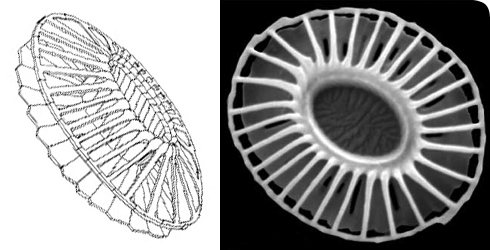Taxonomy
Coccolithophore identification and classification is mainly based on coccoliths, the elaborate calcareous plates they produce.
Technical description of Emiliania huxleyi
- Produces monomorphic coccospheres composed of interlocking elliptical placolith coccoliths 3-4µm long.
- There is often only a single layer of 6 to 10 coccoliths, but coccospheres can have multiple layers of coccoliths.
- The coccoliths have a distinctive perforate appearance since the distal-shield elements are hammer-shaped with gaps between them.
- Slits can also occur between the proximal shield elements and there is usually a grill of delicate elements in the central area.
- The entire coccolith is formed of a single cycle of 20 to 40 crystal units with radial calcite c-axes.
Monomorphic coccospheres
Some coccolithophores form their coccospheres from 2 or more different types of coccoliths (Young et al. 1997). Monomorphic coccospheres, like those of E. huxleyi, contain only one type of coccolith.
Placolith coccoliths
Coccolith shape is highly variable between coccolithophore species, but the most common type are placoliths. These are rivet-shaped coccoliths formed of 2 flange-like shields separated by a tube. This is an efficient design, since the individual coccoliths slot together to form a robust coccosphere which can grow by insertion of extra coccoliths.
Multiple layers of coccoliths
One of the unusual features of E. huxleyi is that it can produce multilayered coccospheres. Specimens can often have 50 or more coccoliths.
Crystal units
The structure of individual E. huxleyi coccoliths is best seen in broken specimens, when it can be seen that the different elements of the proximal (lower/inner) shield, distal (outer/upper) shield and tube and central area are interconnected and all formed from a single, rather complex-shaped, calcite crystal-unit.
An intriguing complication of this basic structure is that the tube is formed of distinct inner and outer layers with the elements sloping in opposite directions. These lock the crystal units together so that the entire coccolith does not fall apart, like a chocolate orange, but forms a robust structure.
Overall the coccolith shape and structure is a remarkable example of bioengineering in miniature.
-

Lookalikes
Learn about the close relatives of Emiliania huxleyi and how they can be distinguished. Get information about how the appearance of E. huxleyi varies and what this might mean.
-

Evolution
It appears that Emiliania huxleyi is the latest in a succession of closely-related species to dominate coccolithophore assemblages in the fossil record. Learn more about the fossil record that exists for this species and what might be causing these changes in dominance.
